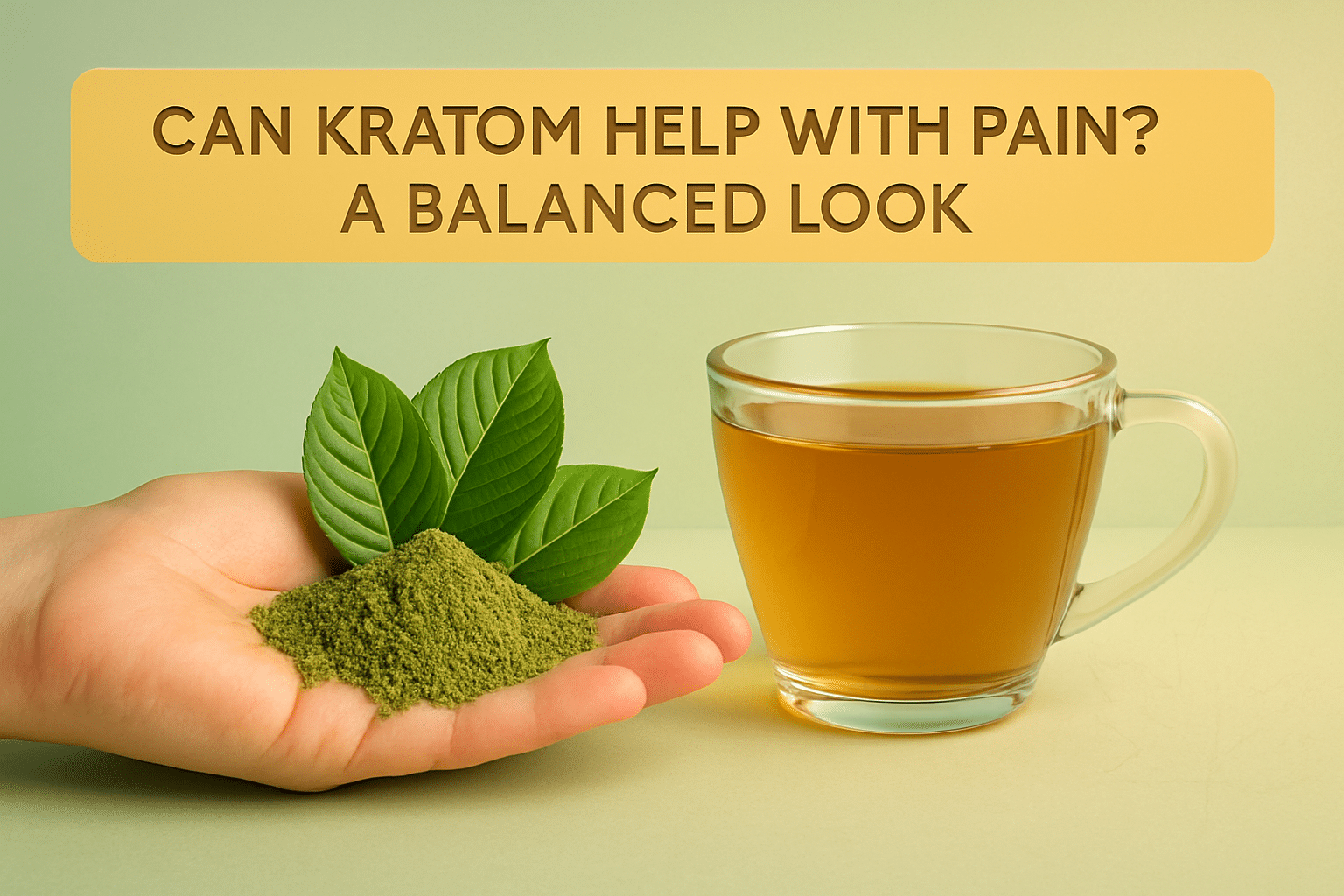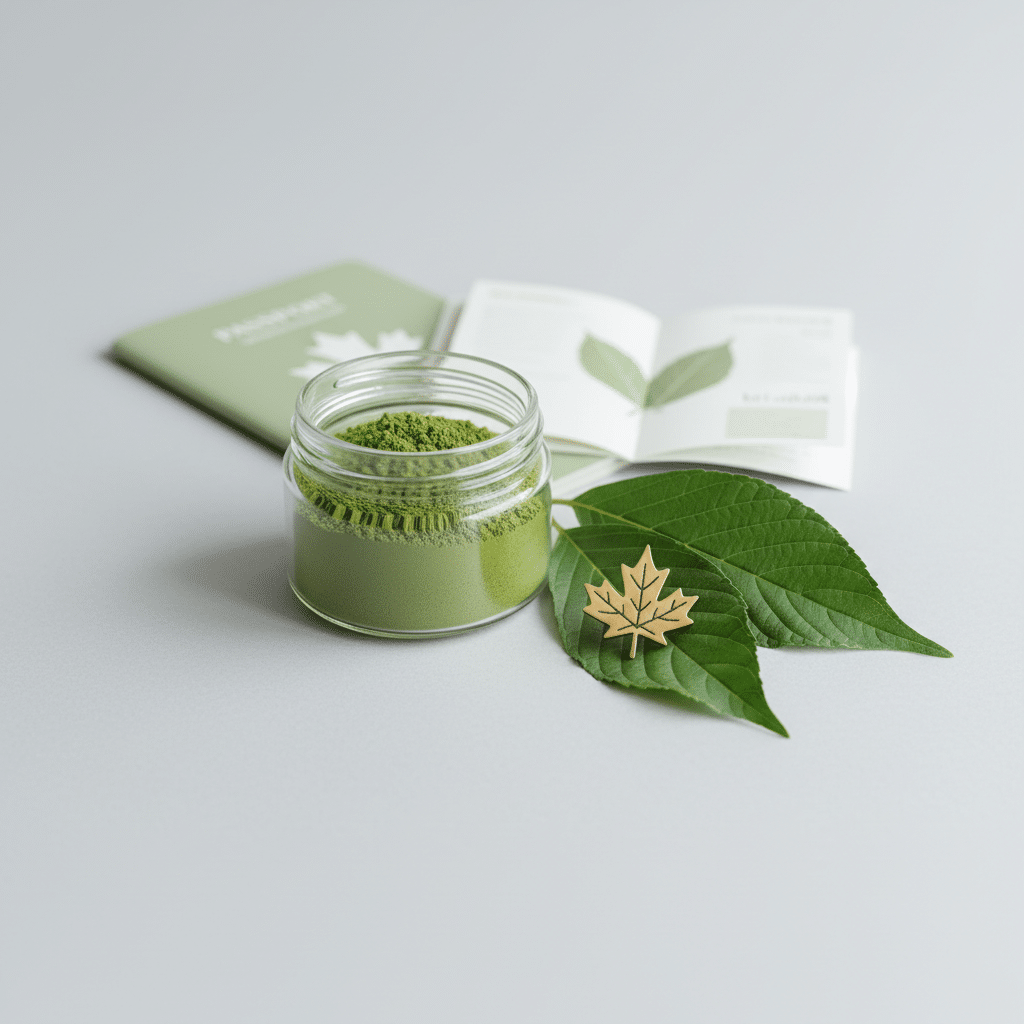
Introduction
Chronic pain affects millions of Canadians, with nearly 8 million adults experiencing persistent discomfort that interferes with daily life. As traditional pain management options face increasing scrutiny, many are exploring alternative approaches. Among these, kratom has emerged as a botanical that’s drawing significant attention for its potential pain-relieving properties. This Southeast Asian plant has been used for centuries by local populations, and now modern research is beginning to validate some of its traditional applications. Understanding how kratom for pain relief works can help Canadians make informed decisions about their wellness journey while navigating the complex landscape of natural pain management options.
Understanding How Kratom Works for Pain Management
The Science Behind Kratom’s Pain-Relieving Properties
Kratom’s effectiveness for pain management stems from its unique interaction with the body’s pain pathways. Recent clinical research has provided compelling evidence for its analgesic potential. A randomized placebo-controlled study found significant increases in pain tolerance among participants who consumed kratom compared to those who received a placebo.
The plant’s pain-relieving effects occur through multiple mechanisms. Unlike synthetic medications that target single pathways, kratom for pain relief engages several systems simultaneously. This multi-target approach may explain why some individuals experience benefits where traditional medications have failed.
Research indicates that kratom’s analgesic properties develop relatively quickly after consumption. The onset typically occurs within 30 to 60 minutes, with effects potentially lasting several hours. This timeline makes it particularly relevant for managing breakthrough pain episodes.
Active Compounds: Mitragynine and 7-Hydroxymitragynine
The therapeutic potential of kratom for chronic pain management lies primarily in two alkaloids: mitragynine and 7-hydroxymitragynine. These compounds represent the plant’s most pharmacologically active constituents. Studies show that two compounds mimic opioid receptor activation differently than morphine, offering a novel approach to pain management.
Mitragynine, the more abundant alkaloid, demonstrates partial agonist activity at opioid receptors. This means it activates these receptors but produces a ceiling effect, potentially reducing the risk of respiratory depression associated with traditional opioids. The compound also interacts with adrenergic and serotonin receptors, contributing to its complex pharmacological profile.
7-Hydroxymitragynine, though present in smaller quantities, exhibits higher potency than mitragynine. This metabolite appears to be responsible for much of kratom’s analgesic activity. Its unique binding profile may explain why kratom for pain shows different side effect patterns compared to conventional opioid medications.
The concentration of these alkaloids varies significantly between different kratom strains and preparations. This variability underscores the importance of consistent, lab-tested products when considering kratom for pain tolerance improvement.
Types of Pain Kratom May Help Address
Chronic Pain Conditions and Kratom Use
Chronic pain represents one of the most researched applications for kratom usage. Recent data demonstrates impressive outcomes across various persistent pain conditions. Research published in 2024 revealed that 93.2% reported pain relief for both chronic and acute pain conditions, highlighting kratom’s broad analgesic potential.
Arthritis sufferers represent a significant portion of individuals exploring kratom for arthritis pain in Canada. The inflammatory component of arthritis may respond particularly well to kratom’s anti-inflammatory properties. Many users report reduced joint stiffness and improved mobility when incorporating kratom into their wellness routines.
Fibromyalgia, characterized by widespread musculoskeletal pain, presents another condition where kratom shows promise. The complex pain patterns associated with fibromyalgia often require multi-modal approaches, making kratom’s diverse mechanism of action potentially beneficial.
Lower back pain, whether from disc degeneration, muscle strain, or nerve impingement, represents another area where individuals report positive outcomes. The muscle-relaxing properties of certain kratom varieties may complement the direct analgesic effects.
Comparing Kratom to Traditional Pain Medications
Traditional pain management typically relies on NSAIDs, acetaminophen, or opioid medications. Each category presents distinct limitations and side effect profiles. NSAIDs carry gastrointestinal and cardiovascular risks, particularly with long-term use. Opioids, while effective, present significant dependency and respiratory depression concerns.
Kratom for pain relief offers a different risk-benefit profile. Preclinical studies suggest promising comparative effectiveness. Research demonstrates that kratom compounds showed better pain blocking than morphine in mice models, indicating superior analgesic potential in controlled settings.
The onset and duration of kratom’s effects differ from traditional medications. While prescription opioids may provide longer-lasting relief, they also carry higher dependency risks. Kratom’s shorter duration may require more frequent dosing but potentially offers better control over intake patterns.
Individual responses to kratom versus traditional medications vary considerably. Some find kratom more effective for neuropathic pain, while others prefer it for muscular discomfort. This variability suggests that kratom may serve different roles within comprehensive pain management strategies.
|
Pain Management Option |
Onset Time |
Duration |
Primary Mechanism |
Dependency Risk |
|---|---|---|---|---|
|
Kratom |
30-60 minutes |
3-6 hours |
Multiple receptor systems |
Moderate |
|
Prescription Opioids |
15-30 minutes |
4-12 hours |
Opioid receptor agonism |
High |
|
NSAIDs |
30-120 minutes |
4-8 hours |
COX enzyme inhibition |
Low |
|
Acetaminophen |
30-60 minutes |
4-6 hours |
Central pain pathway modulation |
Low |
Dosage Guidelines and Best Practices
Finding Your Optimal Kratom Dosage for Pain Relief
Determining appropriate kratom dosage for pain relief requires careful consideration of individual factors. Body weight, pain severity, tolerance levels, and previous experience all influence optimal dosing strategies. Canadian users should start with conservative amounts and gradually adjust based on response.
Beginning users typically benefit from starting with 1-2 grams of kratom. This allows assessment of individual sensitivity without overwhelming effects. Those with more severe pain conditions may eventually require 3-5 grams, though this should be reached gradually over time.
The relationship between dose and effect isn’t always linear with kratom. Lower doses often produce stimulating effects, while moderate amounts tend to provide optimal pain relief. Higher doses may increase sedation without proportionally improving analgesia, making careful titration essential.
Timing considerations matter significantly for kratom dosage effectiveness. Taking kratom on an empty stomach typically produces faster onset but may increase nausea risk. Consuming it with light food can reduce gastrointestinal discomfort while maintaining therapeutic benefits.
Strain Selection for Different Pain Types
Different kratom varieties offer distinct alkaloid profiles and effects. Understanding these differences helps match specific strains to individual pain conditions and personal preferences.
Red-veined kratom varieties typically provide the strongest analgesic effects. These strains often work best for severe chronic pain, arthritis, and conditions requiring significant pain reduction. They tend to produce more sedating effects, making them suitable for evening use.
White-veined strains offer pain relief combined with energizing effects. These varieties may benefit individuals who need pain management without sedation, particularly those dealing with fatigue-inducing conditions. They’re often preferred for daytime use when maintaining alertness is important.
Green-veined kratom provides balanced effects between red and white varieties. These strains offer moderate pain relief with mild mood enhancement, making them versatile options for many users. They represent good starting points for those new to kratom for pain management.
Quality considerations remain paramount regardless of strain selection. Products from reputable suppliers who provide comprehensive testing ensure consistent alkaloid profiles and safety standards.
Safety, Side Effects, and Risk Factors
Understanding Potential Side Effects
Kratom for pain relief, like any botanical supplement, can produce side effects that users should understand before beginning use. Common adverse effects include nausea, constipation, dry mouth, and dizziness. These typically occur more frequently with higher doses or when kratom is consumed on an empty stomach.
Gastrointestinal effects represent the most frequently reported side effects. Nausea and vomiting can occur, particularly in new users or when doses are increased too rapidly. Starting with smaller amounts and gradually increasing can minimize these effects.
Sleep disturbances may occur, especially with stimulating kratom varieties or when consumed late in the day. Some users report vivid dreams or altered sleep patterns when first beginning kratom use. These effects often diminish with continued use.
Kratom can interact with certain medications, particularly those metabolized by liver enzymes. Individuals taking prescription medications should consult healthcare providers before incorporating kratom into their pain management routines.
Dependency and Tolerance Concerns
Long-term kratom use raises important considerations about dependency and tolerance development. While research suggests kratom may have lower abuse potential than traditional opioids, regular use can still lead to physical dependence.
Encouraging findings from recent research indicate no significant link between pain levels and kratom use frequency, suggesting that therapeutic use patterns may differ from recreational misuse patterns. This research provides reassurance for individuals considering kratom for chronic pain management Canada applications.
Tolerance can develop with regular kratom use, requiring dose increases to maintain effectiveness. Rotation between different strains and taking periodic breaks can help minimize tolerance development while maintaining therapeutic benefits.
Withdrawal symptoms may occur when discontinuing kratom after regular use. These typically include mild flu-like symptoms, irritability, and sleep disturbances. Gradual dose reduction rather than abrupt cessation can minimize withdrawal discomfort.
Quality and Purity Considerations
The unregulated nature of the kratom market makes quality assurance a critical safety consideration. Products may vary significantly in alkaloid content, purity, and contamination levels without proper testing and oversight.
Heavy metal contamination represents a significant concern with some kratom products. Lead, mercury, and other toxic metals can accumulate in plants grown in contaminated soil or processed under poor conditions. Comprehensive testing helps identify and avoid these products.
Microbiological contamination, including bacteria, yeast, and mold, can pose health risks. Proper processing, storage, and testing protocols help ensure product safety and shelf stability.
Adulteration with synthetic compounds or other botanicals can occur in some products. Third-party laboratory testing provides verification of product purity and alkaloid content, ensuring users receive authentic kratom without potentially harmful additives.
Legal Status and Regulations in Canada
Current Legal Landscape
The legal status of kratom in Canada remains complex and evolving. Currently, kratom isn’t approved for human consumption by Health Canada, though it exists in a regulatory gray area that allows its sale for other purposes.
Canadian retailers typically market kratom products for botanical research, aromatherapy, or examination purposes only. This approach allows continued availability while acknowledging the regulatory restrictions on human consumption claims.
Provincial regulations may add additional layers of complexity to kratom availability. Some provinces have implemented specific restrictions while others follow federal guidelines. Canadian consumers should stay informed about local regulations affecting kratom access.
The regulatory environment continues to evolve as research expands our understanding of kratom’s safety and efficacy profile. Future changes could impact availability, quality standards, or approved uses within Canada.
Quality Standards and Consumer Protection
Without formal regulatory oversight, consumer protection relies heavily on industry self-regulation and third-party testing initiatives. Reputable suppliers implement comprehensive quality assurance programs to ensure product safety and consistency.
Laboratory testing for alkaloid content, heavy metals, microbiological contaminants, and adulterants provides essential quality verification. These tests help consumers make informed decisions about product selection and safety.
Proper labeling practices include batch numbers, testing dates, and clear ingredient listings. This information enables traceability and helps consumers verify product authenticity and quality standards.
Industry organizations and advocacy groups work to establish voluntary quality standards and best practices. These initiatives help protect consumers while supporting responsible kratom commerce within existing legal frameworks.
Quick Reference: Kratom Strains for Pain Relief
Red Strains (Best for severe/chronic pain):
-
Highest analgesic potential
-
Most sedating effects
-
Ideal for evening use
-
Suitable for arthritis and fibromyalgia
Green Strains (Balanced pain relief):
-
Moderate analgesic effects
-
Balanced energy/sedation
-
Good for daytime use
-
Versatile for various pain types
White Strains (Pain relief with energy):
-
Mild to moderate analgesia
-
Stimulating effects
-
Best for active pain management
-
Helps with fatigue-related conditions
Frequently Asked Questions
How long does kratom take to work for pain relief?
Kratom typically begins working within 30 to 60 minutes when taken on an empty stomach. Effects may take slightly longer with food but can reduce potential nausea. Peak effects usually occur within 1-2 hours, with pain relief lasting 3-6 hours depending on the dose and individual factors.
Can I use kratom alongside other pain medications?
Kratom can interact with various medications, particularly those processed by liver enzymes. It’s essential to consult with a healthcare provider before combining kratom for pain with prescription medications. Some combinations may increase sedation or other side effects, while others might affect how medications are metabolized.
What’s the difference between kratom and prescription opioids for pain?
While both interact with opioid receptors, kratom’s effects differ significantly from prescription opioids. Kratom has a lower risk of respiratory depression and may have ceiling effects that limit overdose potential. However, kratom’s legal status, quality variability, and shorter duration of action present different considerations compared to regulated prescription medications.
Is kratom safe for long-term chronic pain management?
Long-term kratom safety data remains limited compared to established pain medications. While some individuals use kratom for extended periods, potential concerns include tolerance development, dependency, and the need for quality-assured products. Regular monitoring and healthcare provider consultation are advisable for chronic use scenarios.
How do I choose the right kratom strain for my type of pain?
Strain selection depends on your specific pain type, lifestyle needs, and individual response patterns. Red strains typically offer the strongest pain relief but with more sedation. Green strains provide balanced effects suitable for daytime use. White strains offer mild pain relief with energy enhancement. Starting with small amounts of different varieties can help identify what works best for your situation.
Conclusion
The growing body of research surrounding kratom for pain relief presents encouraging possibilities for Canadians seeking alternative approaches to pain management. From the promising clinical findings showing significant pain tolerance improvements to the unique mechanisms of action that distinguish kratom from traditional opioids, this botanical continues to demonstrate therapeutic potential across various chronic pain conditions.
The key to successful outcomes lies in understanding proper usage, selecting quality products, and maintaining realistic expectations about what kratom can and cannot accomplish. Whether dealing with arthritis, fibromyalgia, or other persistent pain conditions, kratom offers a framework for exploration within comprehensive pain management strategies.
For those interested in exploring lab-tested kratom options, 365kratomcanada.com provides comprehensive product selections with rigorous quality testing. Their commitment to purity and potency testing ensures Canadian consumers have access to reliable, consistent products for their botanical research needs.



